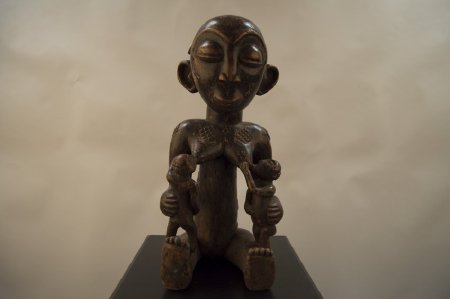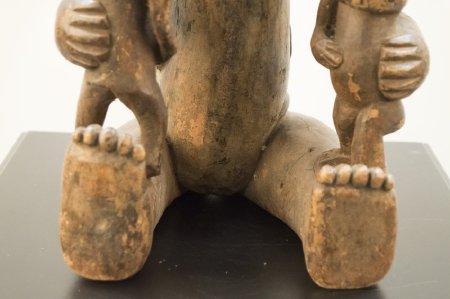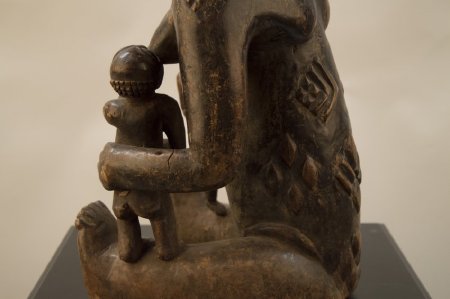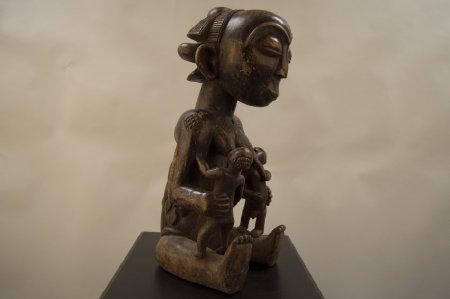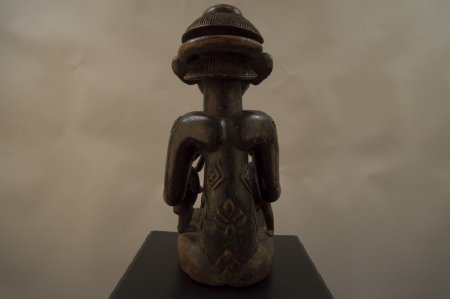Title:
Punu Maternity or Fertility Statue, Mother and Two Babies
Object Name:
Figure, Statue, Punu
Other Name:
Figure, Maternity, Fertility
Place of Origin:
Punu, Gabon, Africa
Provenance:
Aboriginal Indigenous Art.
H = 21"
W = 10"
D = 10"
Punu statues often have protruding pursed lips, globular protruding eyes incised with a curve, high—domed foreheads, and characteristic rigid high coiffures reflecting the Punu women's hair styles. They often have an Oriental expression, but no such influence has been established. Many Punu masks can be recognized by raised diamond—shape scarification marks on the foreheads and temples. The scarification marks on the temples are thought to be associated either with a female ancestor, or with a southern sub—group of the Punu tribe. Black face—masks have exactly the same stylistic characteristics as the white masks, but they are believed to have a judiciary function and help identify sorcerers. The performances of the masks are nowadays intended primarily to entertain audiences on festive occasions. Only rarely do the masqueraders fulfill a ritual function of officiating at funerals, when they dance as embodiments of the ancestor spirits. In performances the dancers, wearing costumes of raffia or cotton fabric and animal pelts, move with amazing acrobatic agility on stilts up to six and a half feet in height.
H = 21"
W = 10"
D = 10"
Punu statues often have protruding pursed lips, globular protruding eyes incised with a curve, high—domed foreheads, and characteristic rigid high coiffures reflecting the Punu women's hair styles. They often have an Oriental expression, but no such influence has been established. Many Punu masks can be recognized by raised diamond—shape scarification marks on the foreheads and temples. The scarification marks on the temples are thought to be associated either with a female ancestor, or with a southern sub—group of the Punu tribe. Black face—masks have exactly the same stylistic characteristics as the white masks, but they are believed to have a judiciary function and help identify sorcerers. The performances of the masks are nowadays intended primarily to entertain audiences on festive occasions. Only rarely do the masqueraders fulfill a ritual function of officiating at funerals, when they dance as embodiments of the ancestor spirits. In performances the dancers, wearing costumes of raffia or cotton fabric and animal pelts, move with amazing acrobatic agility on stilts up to six and a half feet in height.
Description:
Sitting wooden female figure. Large oval—shaped protruding slit eyes, in heart—shaped concave face. Wedge—shaped nose with slightly flared nostrils, over slightly protruding crescent—shaped mouth, which gives the appearance of grinning. Large protruding crescent—shaped ears, round blad top of head, leading back to three ringed coiffure in back of head, ending in a short tail at bottom. Broad shoulders leading to arms carved away from the body, with each hand clasping the mid—section of a child. Pointed elongated breasts, nursing children. Short squat torso and legs in seated position, extending out to feet. Diamond / criss—cross shaped scarification over entire back, sides of upper shoulders and upper front cheast area. Dark brown patina covering entire surface area.
Collection:
Guy Mace Collection, (Turblex Company)
Material:
Wood W/Patina
Used:
Ritually Used
Technique:
Carving / Painting
Owned:
Art Department, MSSU
Accession#:
2015.2.34
